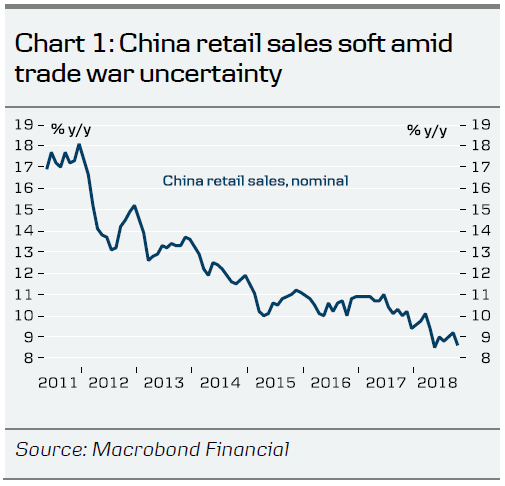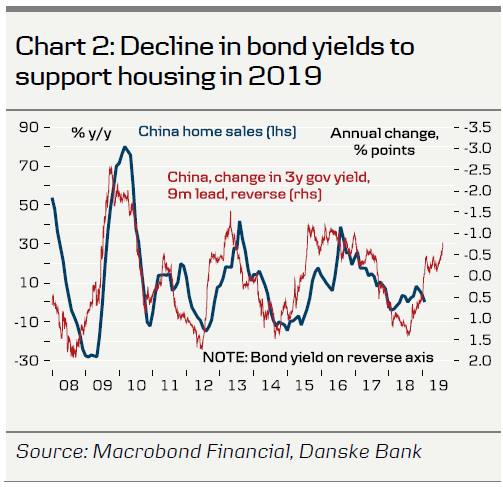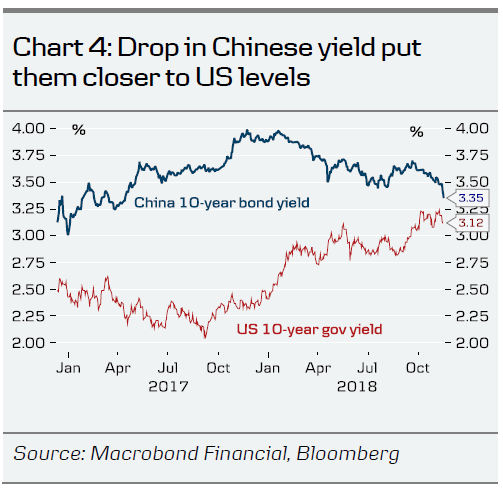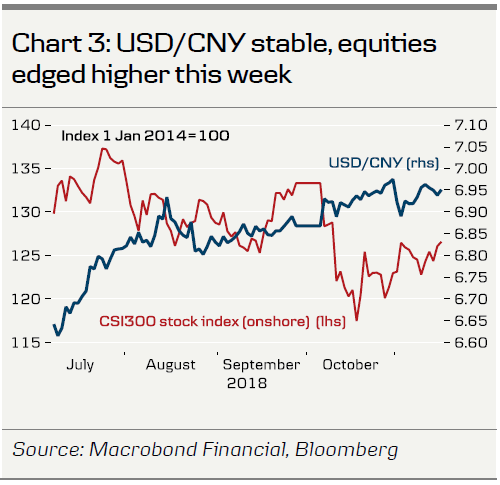Key points this week
- Lots of speculation about the Xi-Trump meeting
- Economic data points to more weakness short term
- Trade deal or not – rivalry here to stay
Continued speculation about the Xi-Trump meeting
A lot of stories about the upcoming Xi-Trump meeting have surfaced this week. According to Trump’s economic adviser Larry Kudlow there are now talks on ‘all levels’. Yesterday, Trump’s Commerce Secretary Wilbur Ross said that Xi and Trump can only be expected to get a framework deal in place, but that it would take a long time to negotiate the whole list of 132 US demands, see Bloomberg. Ross also stated, that the US was still planning to raise the tariff rate from 10% to 25% on USD200bn of imports on 1 January. According to Reuters, China has delivered a written response to US demands that could form the basis for the negotiations. Two of Trump’s trade advisors, the ultra-hawk Peter Navarro and Larry Kudlow, clashed openly as Kudlow criticized recent comments by Navarro and said the Trump administration has deliberately curtailed Navarro’s public role, see CNBC and Politico.
Comment. The upcoming Xi-Trump meeting is no doubt the most important event for China in the short term. If they manage to agree on a ceasefire that paves the way for serious negotiations next year, it could be the beginning of the end of the trade war with a deal struck in 2019. However, if Trump is not satisfied with Chinese concessions, we could be looking at tariffs on all Chinese imports early next year, adding significant further downward pressure on the Chinese economy. We still see a 60% probability of a ceasefire. If Trump escalates further, it could hit him like a boomerang by sending US stock markets lower, hurting consumers and weakening the US economy. That would weaken his hand in the trade war. It is the most likely reason why we have seen Trump take steps to restart talks after he for a long period repeated, that ‘now is not the time’. It is unclear whether a tariff increase on 1 January from 10% to 25% is coming regardless as Ross state. My sense is that it would be a deal breaker for China in restarting real talks as they will not negotiate with ‘a gun to their head’. For more on the Xi-Trump meeting see FT,
Economic data points to more weakness short term
Data this week showed further softness in retail sales (chart 1) and credit growth. However, there is a small ray of light in money growth, where the momentum in M1 is showing some stabilisation. A further decline in bond yields also gives support to housing (chart 2), which is set to be one of the stabilising pillars in China along with infrastructure investments. House price data for October showed an increase of 9.7% y/y up from 8.9% y/y in September driven by increases in tier-3 and tier-4 cities.
Comment. We expect further downward pressure on the Chinese economy in the next two quarters but a bottom at some point in Q2 as stimulus kicks in and (hopefully) the trade war uncertainty moves down a notch. China may step harder on the gas in 2019 through tax cuts and possibly further reductions in the Reserve Requirement Ratio.
Trade deal or not – rivalry is here to stay
While the US and China are working on a path to make a trade deal, the longer term rivalry is likely here to stay. This week Vice-President Pence warned China of rising aggression in the Indo-Pacific in a speech held in Singapore at the East Asia Summit: ‘We all agree that empire and aggression has no place in the Indo-Pacific’. However, he also reached out saying ‘Let me be clear, though: our vision for Indo-Pacific excludes no nation. It only requires that nations treat their neighbors with respect, and respect the sovereignty of our nations and international rules and order’, see SCMP. Mike Pence is said to be unveiling a rival to the ‘dangerous’ Belt and Road Initiative, at the APEC meeting this weekend.
Comment. Maybe the most noteworthy thing about Mike Pence’s visit was that he was sent as stand-in for Donald Trump at the APEC summit in Papa New Guinea. China on the other hand is represented by President Xi Jinping, see The Guardian. While Mike Pence assured the Asian nations in his speech, that the US commitment to the region was strong, Trump’s absence at the APEC meeting is weakening this signal.
The Indo-Pacific will be just one of the places where the US-China rivalry will play out in the coming years. Among other things, the US can be expected to do more ‘Navigation of freedom’ cruises in the South China Sea, challenge China further on the Taiwan issue and increase investments in infrastructure as a counterbalance to China’s Belt and Road Initiative. The recent near-collision between a US and Chinese cruise ship is testament to the tensions ahead. Another battle front will be increased US export controls of tech products and other measures to stop technology transfer to China, see WSJ.
Other China news this week
US study shows US military advantage has eroded and the US could lose a war against China or Russia. The study was released by a bipartisan commission that Congress created to evaluate the Trump administration’s defence strategy, see SCMP here and here.
Chinese bond yields fell sharply this week (chart 4), see Bloomberg. Expectations of a further reduction in the Reserve Requirement Ratio before year-end are fuelling demand for bonds as it frees up more liquidity in the banks.
CNY stable while stocks edge higher (chart 3). We look for USD/CNY to stay around the current level for a while before rising gradually towards 7.20 in 12M on diverging monetary policy, see FX Forecast Update(page 15), 15 November 2018. Stock markets edged a bit higher but have moved broadly sideways over the past two months.
China’s tech giant Tencent beat earnings expectations, see Bloomberg. Concerns over their gaming business still linger, though, following government restrictions.
Alibaba set new record on Singles day. Total sales worth USD30.8bn was a 27% increase from last year’s previous record of USSD25bn, see Forbes.
IMF released a Working Paperon China’s rebalancing. The paper concludes that rebalancing in 2017 ‘was uneven and decelerated along many dimensions reflecting the temporary factors behind the growth pick-up. Going forward, rebalancing is expected to proceed as these temporary factors recede, but elevated income inequality and leverage will remain a challenge.’

















